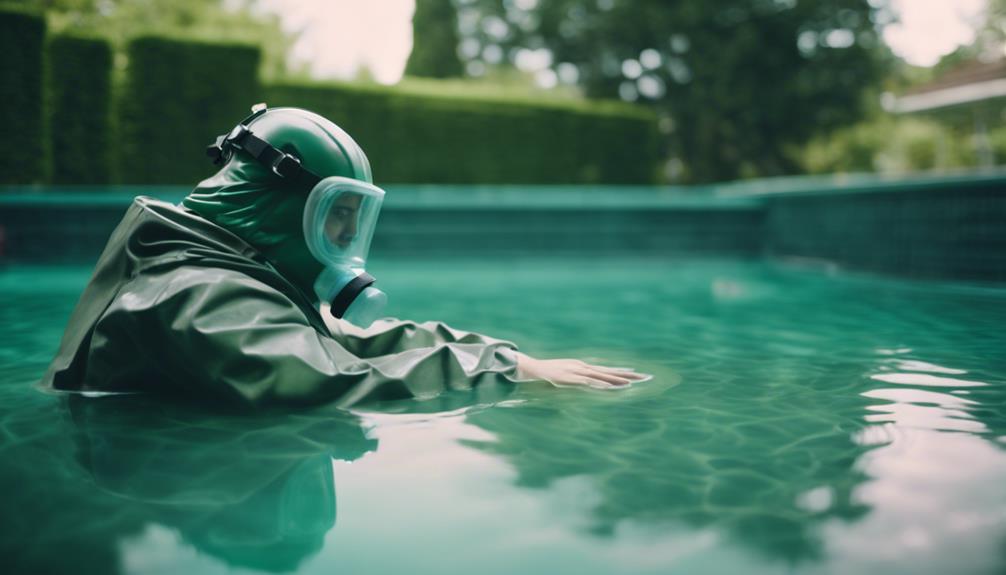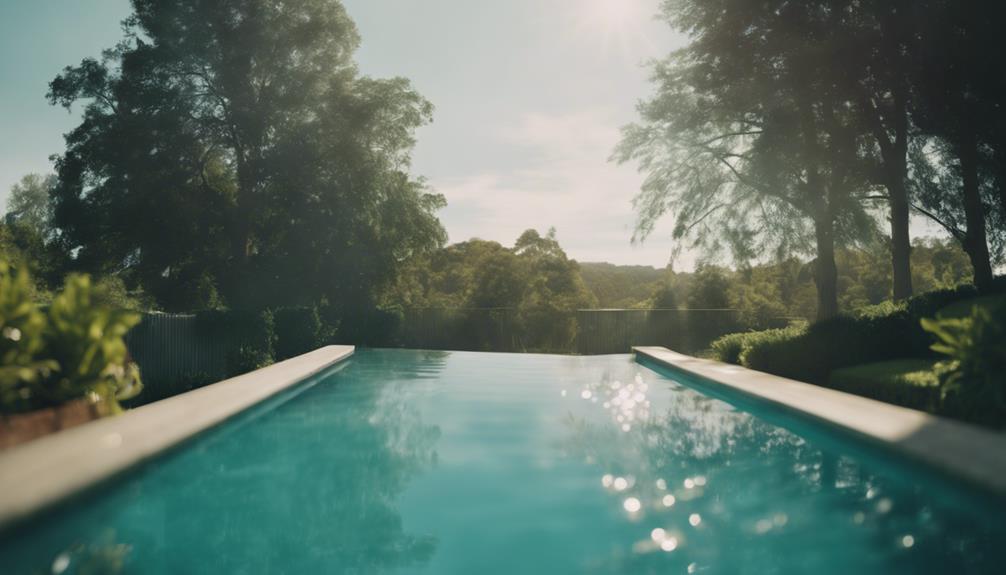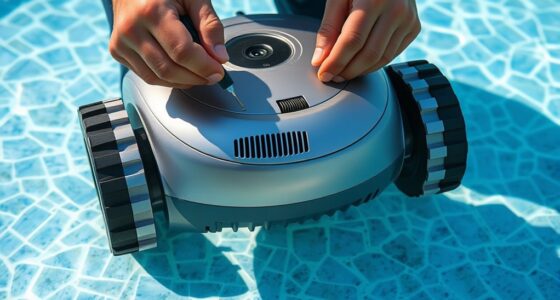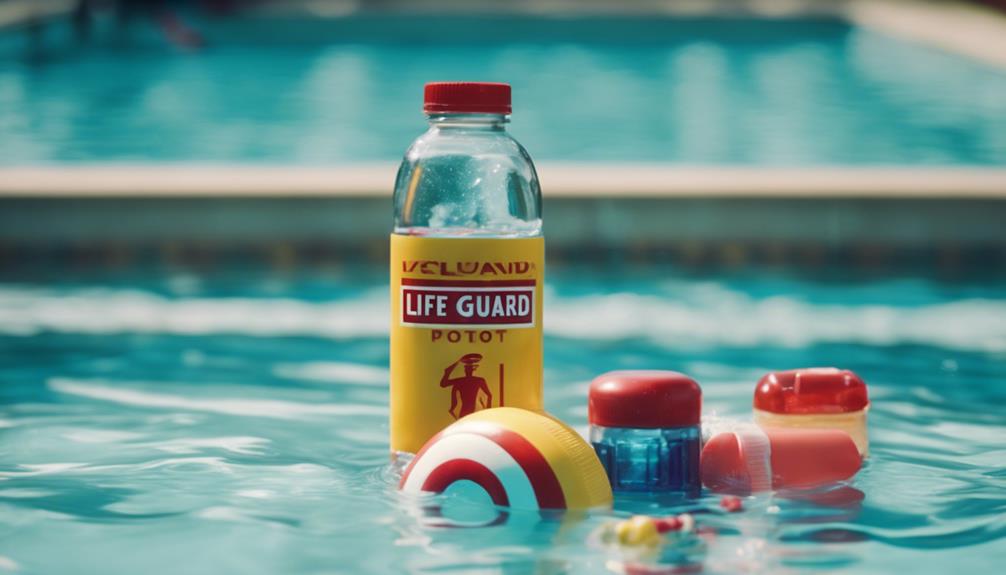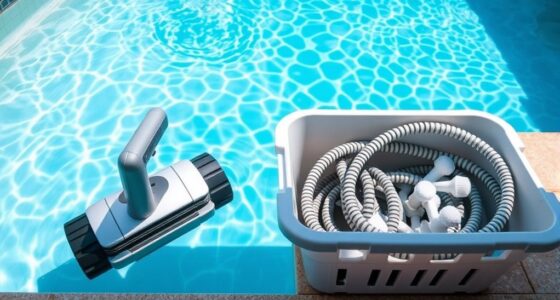When dealing with a green pool, it is important to identify the causes such as algae overgrowth due to low sanitizer levels or high pH. In order to remedy the situation, it is essential to thoroughly brush and vacuum the pool, test and adjust pH levels, utilize shock treatment, and ensure the filter is running properly. To maintain well-balanced water, monitor pH and stabilizer levels regularly, and maintain appropriate chlorine levels. Upgrading the filtration system and keeping it clean is also crucial in preventing algae growth. If you experience high chlorine levels, test the water frequently and dilute as necessary. It is important to note that using only baking soda as a quick fix is not sufficient – patience and a systematic approach are key. If persistent issues persist, it may be necessary to seek professional assistance.
Key Takeaways
- Ensure proper chlorine levels and pH balance.
- Thoroughly brush, vacuum, and shock treat the pool.
- Keep the filtration system running continuously.
- Test and adjust water chemistry regularly.
- Address underlying causes like low sanitizer levels.
Common Causes of Green Pool Water
If your pool water has turned green, it's likely due to common causes such as algae overgrowth from low sanitizer levels or high pH. Algae, microscopic organisms that thrive in warm and stagnant water, can quickly multiply when chlorine levels are insufficient. Chlorine plays an essential role in killing and preventing algae growth, so low levels can lead to that unsightly green color in your pool.
Additionally, high pH levels above 7.8 create an environment where algae can flourish, further contributing to the green hue of the water.
Maintaining proper sanitizer levels and balanced pH is important in preventing algae from taking over your pool. Regularly testing and adjusting these levels can help keep your pool water clear and inviting.
Steps for Cleaning a Green Pool

To effectively address the green color in your pool water caused by algae overgrowth, it's essential to follow specific steps for cleaning and restoring water clarity. Begin by thoroughly brushing and vacuuming the pool to remove algae buildup and debris.
Test the alkalinity and pH levels to guarantee the proper chemical balance for effective cleaning. Utilize a double or triple shock treatment to kill algae and bacteria present in the pool water.
It's important to run the pool filter continuously to eliminate dead algae and maintain water clarity. Repeat this cleaning process until the water is clear, especially in severe cases of a green pool, as it may take a few days for the water to become completely clean.
Testing and Balancing Pool Water

Testing your water regularly is vital to maintaining the correct water balance. Start by checking the pH levels, aiming for a range of 7.4-7.6. This guarantees that chlorine can work effectively to kill algae.
Additionally, maintaining stabilizer levels between 30-60 ppm is critical to prevent chlorine degradation caused by sunlight exposure.
If your pH levels are off, you can adjust them using soda ash or baking soda to raise the levels, and muriatic acid or sodium bisulfate to lower them. Remember, imbalanced pH can hinder chlorine's ability to combat algae effectively.
Properly balanced pool water is key to ensuring that shock treatments and chlorine can efficiently clear algae from your pool. By upholding the right water balance, you set the stage for a clean and healthy swimming environment.
Regular testing and adjustments will help you achieve and maintain the desired pH and alkalinity levels for optimum pool water quality.
Importance of Pool Filtration

Proper pool filtration is essential for keeping your pool water clean and free of contaminants. Maintaining your filtration system promotes efficient circulation and helps prevent algae growth.
Regularly cleaning and upgrading your filter system are vital steps to guarantee peak performance and water clarity.
Filter Maintenance Tips
Maintaining your pool filters is essential for ensuring clean and safe water for swimming. Proper pool maintenance includes regular filter upkeep to eliminate algae, debris, and harmful bacteria.
To uphold efficient water circulation and filtration, clean or replace the filter media as needed. Neglecting filter maintenance can lead to the reintroduction of algae into the pool, jeopardizing water quality.
Consider upgrading to a reliable pool pump to enhance filtration efficiency and overall water clarity. Backwashing the filtration system when necessary is important in preserving best filter performance.
Filter System Upgrade
Upgrading your pool filter system enhances water clarity by boosting filtration efficiency and reducing algae buildup. A reliable pool pump aids in better water circulation, further diminishing algae infestations. Proper maintenance of filter media is essential to prevent the reintroduction of algae into the pool after an upgrade.
In addition to upgrading the filter system, consider using algaecide as a preventative measure against green pool issues. Upgrading your pool filter system is a proactive step in preventing algae infestation and maintaining a clear pool. By investing in a more efficient filtration system, you're taking a significant stride towards enjoying a sparkling, algae-free pool.
Troubleshooting Persistent Green Water

If your pool water remains persistently green, it may be due to high copper levels that necessitate testing for confirmation.
Guarantee proper pH and alkalinity levels are maintained for effective treatment against algae growth.
Additionally, inspect your filtration system and understand the nuances between total and free chlorine levels to troubleshoot and resolve green water issues efficiently.
Algae Growth Causes
To troubleshoot persistent green water in your pool, identifying the root causes of algae growth is vital. Algae overgrowth is often triggered by low chlorine levels, creating an environment where algae can flourish unchecked. Additionally, inadequate water circulation can lead to stagnant areas where algae thrive, contributing to the green tint of your pool water. Factors like high pH levels can also exacerbate algae growth, making it essential to maintain proper water balance.
After heavy rains, algae can quickly multiply, causing green water despite regular maintenance efforts. If shock treatments fail to resolve the issue, it may indicate other underlying problems such as elevated copper levels or imbalanced pH. To combat persistent algae growth and green water, it's important to address these causes through thorough testing, cleaning, and ensuring efficient water circulation to prevent future outbreaks.
Chlorine Levels Check
How can you effectively troubleshoot persistent green water in your pool?
Start by testing the chlorine levels in the water to make sure they fall within the recommended range. Low chlorine levels can lead to the presence of algae, causing the water to turn green. If your chlorine levels are low, consider administering a shock treatment to eliminate the algae and restore water clarity. Proper chlorine levels are important for effectively killing algae and maintaining a clean pool.
By monitoring and adjusting chlorine levels regularly, you can address persistent green water issues promptly. Remember, persistent green water is often a sign of chlorine deficiency, indicating the urgent need for intervention to improve water quality.
Stay vigilant with your chlorine levels to prevent algae growth and ensure your pool water remains clear and inviting for swimmers.
Filtration System Inspection
Check for clogs or blockages in your pool's filtration system to troubleshoot persistent green water, ensuring essential water circulation to address the issue effectively.
Inspecting the filter media is vital to identify any debris buildup that could be impeding filtration. Dirty filters are a common culprit for contributing to green water problems.
Additionally, make sure that the filter settings are correct and that the pump is operating efficiently to aid in clearing the pool water. It's important to look out for any cracks or damage in the filtration system components as these issues can greatly impact filtration effectiveness.
If your troubleshooting efforts don't resolve the green water issue, consider backwashing the filter or seeking professional maintenance help.
Taking these steps will help you maintain a clean and healthy pool environment by ensuring that your filtration system is functioning efficiently to keep the water clear and free from algae.
Dealing With High Chlorine Levels

If you notice high chlorine levels in your pool, take immediate action to prevent skin and eye irritation. High chlorine levels can be a result of over-shocking the pool or an imbalance in chemical levels.
To address this issue effectively, follow these steps:
- Test Your Pool Water: Regularly test your pool water to verify that chlorine levels are within the recommended range. High levels can be harmful and should be corrected promptly.
- Dilute the Chlorine: If you find high chlorine levels, dilute the water by adding fresh water to the pool. This will help bring the chlorine levels back to a safe range.
- Review Your Shocking Routine: Evaluate your shocking routine to make sure you aren't overdoing it. Over-shocking can lead to excessively high chlorine levels.
- Seek Professional Help: If your chlorine levels remain consistently high despite your efforts, consult a pool maintenance professional. They can help identify the root cause of the issue and provide the necessary solutions.
Quick Fixes and Myths Debunked

To effectively address quick fixes and debunk common myths in maintaining a green pool, it's important to understand the limitations of certain remedies and the truth behind common misconceptions. Quick fixes such as using baking soda alone may not clear a green pool effectively, as it primarily raises pH levels without addressing the root cause of the issue. Additionally, the myth that simply tossing chlorine tablets into the skimmer will eliminate algae is false; proper shock treatment is essential for algae eradication. Remember, running the pool filter continuously, not just for a short period, is crucial for optimal circulation and clearing a green pool. Merely adding algaecides without a systematic approach won't fully eliminate algae growth. Lastly, don't fall for the misconception that a green pool will clear overnight. It requires a systematic approach, including proper shock treatment and patience, for effective results.
| Myth Debunked | Fact |
|---|---|
| Baking soda alone clears a green pool | Raises pH levels, doesn't address root cause |
| Chlorine tablets in skimmer eliminate algae | Proper shock treatment needed for algae removal |
| Running filter briefly clears green pool | Filter should run continuously for optimal circulation |
| Adding algaecides solves algae issue | Must address root cause for full elimination |
Professional Help and Maintenance Services

Consider engaging professional pool maintenance services from ASP – Americas Swimming Pool Company to address your green pool effectively. When it comes to pool care, experts like ASP offer specialized services to tackle green pool issues with precision and efficiency. Here are four reasons why professional help from ASP can make a difference:
- Expertise: ASP professionals are trained in dealing with green pools and can provide the best solutions based on your pool's specific needs.
- Efficiency: Their Green to Clean services are designed to swiftly and effectively remove algae infestations, restoring your pool to its sparkling condition.
- Quality Service: With year-round maintenance options, ASP ensures your pool remains clean and healthy, avoiding future green pool incidents.
- Nationwide Availability: ASP franchise opportunities mean you can access high-quality pool maintenance services wherever you're in the country.
For reliable and expert assistance with your green pool problems, reach out to ASP for a clear and enjoyable pool experience.
Frequently Asked Questions
What Do I Need to Fix a Green Pool?
To fix a green pool, you need pool cleaning equipment like brushes, vacuums, and pool shock. Testing kits for pH, alkalinity, and chlorine levels are crucial for diagnosis.
Proper maintenance products such as algaecides and clarifiers aid in clearing algae. Make sure the pool filter runs continuously for at least 24 hours to remove dead algae and debris.
Regularly monitor and balance pool water chemistry to prevent future green pool issues.
How Long Does It Take for a Green Pool to Clear up After Being Treated?
After being treated, a green pool typically takes anywhere from a few days to a week to clear up, depending on the severity of the algae infestation. Proper cleaning, chemical balancing, and filtration are essential for speeding up this process.
Consistently monitor and adjust chlorine levels to prevent future algae growth. Running the pool filter for at least 8 hours daily aids in clearing the water effectively.
Maintenance and prevention help avoid green pool issues, saving time and effort.
Why Is My Pool Still Green After Shock and Algaecide?
If your pool remains green after shock and algaecide treatments, inadequate circulation, filtration, or persistent algae growth could be the culprits. Guarantee proper water circulation and filtration, and consider additional shock treatments or a thorough cleaning.
Retest and balance pH, alkalinity, and chlorine levels post-treatment. Factors like high copper levels or inefficient filtration systems may also be at play.
Consult a professional pool service for expert advice on resolving persistent green pool issues.
How to Clear Green Pool Water Fast?
To clear green pool water fast, follow these steps:
- Thoroughly brush and vacuum the pool to remove algae and debris.
- Test and balance alkalinity and pH levels for best water conditions.
- Apply double or triple shock treatments to kill algae quickly.
- Keep the pool filter running continuously to clear out dead algae.
- Repeat the cleaning process diligently until the water becomes clear and free of algae.
What Are the Best Methods to Prevent Pool Water from Turning Green?
The best practices for preventing green pool water include regularly testing and maintaining the water’s pH levels, sanitizing with chlorine or other chemicals, maintaining proper water circulation and filtration, and regularly cleaning debris from the pool. Additionally, using a pool cover when the pool is not in use can also help prevent algae growth.
Conclusion
To sum up, maintaining a clean and properly balanced pool is essential for a safe and enjoyable swimming experience. Remember, a green pool can be a result of various factors, but with the right knowledge and steps, it can be easily remedied.
Don't fall for quick fixes or myths – trust in the proper testing, cleaning, and maintenance techniques to keep your pool sparkling and inviting.
Remember, a little prevention goes a long way in keeping your pool in top shape!

